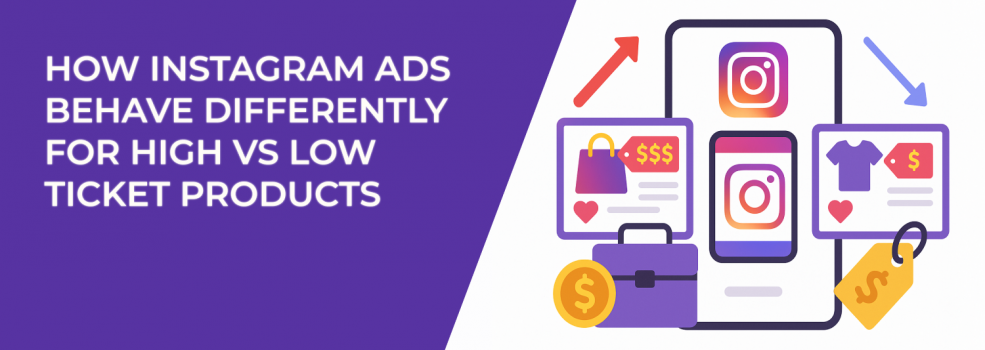Instagram has matured into more than just a photo-sharing app — it's now a full-fledged sales engine. But if you're treating $25 and $2,500 products the same way in your ad strategy, you're leaving results on the table.
Understanding how Instagram ads behave differently depending on product price can drastically improve your ROAS, reduce wasted ad spend, and help you build better user journeys that convert.
This article breaks down what changes when you're marketing low-ticket vs high-ticket products — and how to adapt accordingly.
1. Impulse vs. Consideration: The Core Divide
Price changes everything. And the biggest difference between low-ticket and high-ticket products lies in how people make buying decisions on Instagram.
Low-ticket items — typically under $50 — tend to be purchased on impulse. A user might see an ad for a quirky phone accessory, click, and check out in 30 seconds. They don't need a backstory, a comparison chart, or a 12-step funnel.
High-ticket products — anything from $200 up to several thousand — require more than a scroll and a spark of interest. They demand time, trust, and information. The decision is deliberate, not impulsive.
So how do you support each type of decision? Let’s look at how to structure your creative.
2. Creative Direction: Quick Triggers vs. Deep Value
Your ad creative is the bridge between your offer and the buyer’s mindset. If that bridge doesn’t match the journey your audience is prepared to take, your campaign won’t land.
When you're promoting low-ticket products, your creative should spark desire and remove hesitation in seconds. Here's what works well:
Low-ticket product creative should focus on:
-
Visually striking images or video that instantly stand out in the feed. Use color, motion, or oddity to stop the scroll.
-
Short-form videos demonstrating usage in under 10 seconds. Reels work great for this.
-
Clear, specific product benefits, such as “waterproof,” “reusable,” or “fits in your pocket.”
-
Simple emotional hooks — “Perfect gift,” “Must-have gadget,” “Get it before it’s gone.”
-
Limited-time urgency — countdowns, discounts, or limited quantities.
In contrast, high-ticket offers can't rely on a single image or a punchy slogan. You need depth, clarity, and trust — especially if you're targeting cold audiences.
High-ticket product creative should focus on:
-
Transformation or value-driven storytelling — What changes for the buyer after they purchase?
-
Carousel ads to break down features, modules, or key results. Each card should give new value.
-
Testimonials, success stories, or social proof, especially from credible clients.
-
Behind-the-scenes content or “Meet the founder” style assets that humanize your brand.
-
Educational content that builds expertise — webinars, tutorial snippets, or FAQ highlights.
The goal isn’t just to explain the product. It’s to reduce risk, increase desire, and make the investment feel safe.
3. Click Behavior and the Path to Purchase
Click behavior tells you a lot about buyer intent — and how long your funnel needs to be.
Low-ticket buyers often follow a simple and fast path:
Ad → Product Page → Checkout
They don’t need nurturing emails or retargeting sequences if the ad and product page are well-optimized.
High-ticket buyers, however, take the scenic route. They need multiple exposures, validation, and follow-ups. Their path looks more like:
Ad → Profile visit → Reel or carousel engagement → Website → Email sign-up → Retargeting → Purchase
In this case, your campaign strategy must support each step.
Here’s how users typically engage with high-ticket ads:
-
They revisit your profile to see if you’re legit.
-
They look for reviews or past results — either on your page or elsewhere.
-
They save posts, ask questions, or engage in comments.
-
They convert through retargeting, not the first ad.
If you're not seeing conversions despite clicks, your funnel may be missing the structure high-ticket offers need. Start by reviewing this guide: Why You See “Ad Set May Get Zero” on Facebook and How to Fix It.
4. Campaign Objectives: Different Goals, Different Outcomes
Choosing the wrong campaign objective can sabotage your entire strategy, even with great creative. Instagram's algorithm delivers based on your objective — so you need to align it with both your product type and your user journey.
For low-ticket products, consider:
-
Sales (Conversions): Ideal when you’ve got a short path to purchase.
-
Traffic: Works if you want to test landing pages or compare product pages.
-
Engagement: Good for virality if your creative is meme-like or shareable.
These objectives are designed to trigger fast action. Use them only when your product and landing experience are optimized for impulse buyers.
For high-ticket products, start with:
-
Lead Generation: Capture emails or Messenger leads for further nurturing.
-
Video Views: Warm up cold audiences by educating them about your offer.
-
Engagement: Build social proof by encouraging comments, saves, and shares.
After warming up your audience, move into Conversion campaigns with more specific CTAs.
Need clarity on when to use what? Check out Meta Ad Campaign Objectives Explained: How to Choose the Right One.
5. Targeting Strategy: Broad Reach vs. Layered Precision
Targeting can either amplify or destroy your campaign performance — especially if you’re not tailoring your approach to price sensitivity.
Low-ticket products can rely on Instagram's scale. The goal is volume, not ultra-specific precision.
For low-ticket ads, use:
-
Interest-based targeting, keeping audiences broad (e.g., “Fitness Enthusiasts,” “Travel Shoppers”).
-
Lookalike audiences from recent buyers or site visitors.
-
Auto-expansion features, especially when paired with high-performing creative.
-
Instagram-only placements, if that’s where your conversions are strongest.
High-ticket targeting demands more granular segmentation. You’re looking for intent signals, not just eyeballs.
For high-ticket ads, use:
-
Custom audiences of email subscribers, lead form submissions, or long-form video viewers.
-
Funnel segmentation — different ad sets for cold, warm, and hot audiences.
-
Interest stacking to narrow intent (e.g., layering “Business Coaching” with “Online Courses” and “Income Growth”).
-
Exclude cold audiences once users enter your funnel, to avoid wasting impressions.
For advanced segmentation tactics, don’t miss this breakdown: How to Layer Detailed Targeting for Hyper-Specific Facebook Audiences.
6. Your Instagram Profile Is Part of the Funnel
If you’re only thinking about the ad and the landing page, you’re ignoring a major conversion touchpoint — your Instagram profile.
This matters far more for high-ticket offers. Buyers will almost certainly investigate your presence before spending hundreds or thousands.
To support conversions, your profile should:
-
Pin relevant posts, including testimonials, behind-the-scenes content, or feature breakdowns.
-
Create Highlights that explain your offer, show results, and answer objections.
-
Use your bio and link tools strategically — consider adding a short video or client case study.
-
Ensure consistent branding across your grid, Stories, and Reels.
-
Add calls-to-action in captions that guide visitors to your funnel.
Want a fast way to boost your top-of-funnel engagement? Read How to Use Instagram Reels in Your Marketing Strategy.
Final Thoughts: Build the Right Journey for the Right Product
Low-ticket and high-ticket products operate in different universes on Instagram — and your strategy should reflect that.
Low-ticket products thrive when:
-
Ads focus on instant value and emotional appeal.
-
Funnels are simple and frictionless.
-
Campaigns optimize for quick wins.
-
Creative emphasizes benefits over features.
High-ticket products convert best when:
-
Users are educated before being asked to buy.
-
Multiple touchpoints are in place to nurture trust.
-
Content builds authority, not hype.
-
Audiences are segmented and warmed in stages.
If your campaign isn’t performing, it might not be your product — it could be the mismatch between price and path.

